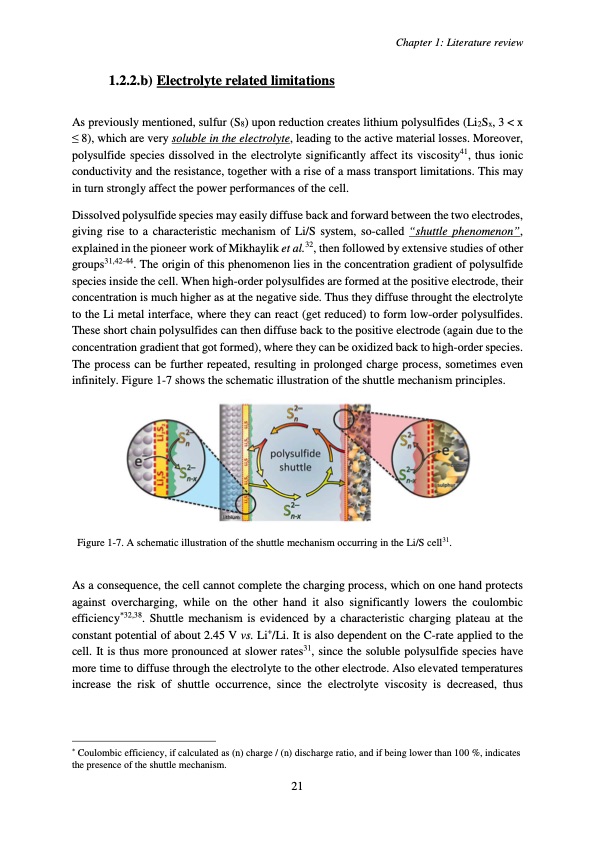
PDF Publication Title:
Text from PDF Page: 025
1.2.2.b) Electrolyte related limitations As previously mentioned, sulfur (S8) upon reduction creates lithium polysulfides (Li2Sx, 3 < x ≤ 8), which are very soluble in the electrolyte, leading to the active material losses. Moreover, polysulfide species dissolved in the electrolyte significantly affect its viscosity41, thus ionic conductivity and the resistance, together with a rise of a mass transport limitations. This may in turn strongly affect the power performances of the cell. Dissolved polysulfide species may easily diffuse back and forward between the two electrodes, giving rise to a characteristic mechanism of Li/S system, so-called “shuttle phenomenon”, explained in the pioneer work of Mikhaylik et al.32, then followed by extensive studies of other groups31,42-44. The origin of this phenomenon lies in the concentration gradient of polysulfide species inside the cell. When high-order polysulfides are formed at the positive electrode, their concentration is much higher as at the negative side. Thus they diffuse throught the electrolyte to the Li metal interface, where they can react (get reduced) to form low-order polysulfides. These short chain polysulfides can then diffuse back to the positive electrode (again due to the concentration gradient that got formed), where they can be oxidized back to high-order species. The process can be further repeated, resulting in prolonged charge process, sometimes even infinitely. Figure 1-7 shows the schematic illustration of the shuttle mechanism principles. Figure 1-7. A schematic illustration of the shuttle mechanism occurring in the Li/S cell31. As a consequence, the cell cannot complete the charging process, which on one hand protects against overcharging, while on the other hand it also significantly lowers the coulombic efficiency*32,38. Shuttle mechanism is evidenced by a characteristic charging plateau at the constant potential of about 2.45 V vs. Li+/Li. It is also dependent on the C-rate applied to the cell. It is thus more pronounced at slower rates31, since the soluble polysulfide species have more time to diffuse through the electrolyte to the other electrode. Also elevated temperatures increase the risk of shuttle occurrence, since the electrolyte viscosity is decreased, thus * Coulombic efficiency, if calculated as (n) charge / (n) discharge ratio, and if being lower than 100 %, indicates the presence of the shuttle mechanism. Chapter 1: Literature review 21PDF Image | Accumulateur Lithium Soufre

PDF Search Title:
Accumulateur Lithium SoufreOriginal File Name Searched:
WALUS_2015_archivage.pdfDIY PDF Search: Google It | Yahoo | Bing
Sulfur Deposition on Carbon Nanofibers using Supercritical CO2 Sulfur Deposition on Carbon Nanofibers using Supercritical CO2. Gamma sulfur also known as mother of pearl sulfur and nacreous sulfur... More Info
CO2 Organic Rankine Cycle Experimenter Platform The supercritical CO2 phase change system is both a heat pump and organic rankine cycle which can be used for those purposes and as a supercritical extractor for advanced subcritical and supercritical extraction technology. Uses include producing nanoparticles, precious metal CO2 extraction, lithium battery recycling, and other applications... More Info
| CONTACT TEL: 608-238-6001 Email: greg@infinityturbine.com | RSS | AMP |